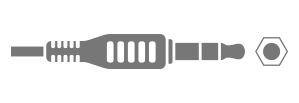Audio Interface Buyers Guide
What is an Audio Interface ?
An audio interface is a piece of hardware that allows you to connect all of your audio gear to your computer. It is responsible for converting analogue signals into digital audio so that your computer can process it. It also performs the same process in reverse by receiving digital audio information from the computer and converting it into an analogue signal that you’re able to hear through your studio monitors or headphones.

Consumer grade soundcards aren’t adequate enough if you’re looking to achieve good quality recordings due to their limited sound quality and connectivity limitations. If you’re serious about recording good quality audio, you will need a dedicated audio interface.
Choosing an Audio Interface
Choosing the right audio interface may seem a little overwhelming. Let’s take a look at some important considerations to take into account so you're better equipped to make the right choice.
Intended Purpose
There are a wide variety of different options available when shopping for an audio interface, each designed to meet the demands of a specific type of recording environment. At the basic level, you’ll find simple two-channel desktop interfaces, great if you’re looking to record a pair of mono signals or a single stereo signal at once. These are ideal for smaller studios where there isn’t the requirement for multiple inputs.
Then there’s are larger interfaces intended for use in larger studios. These are typically rack mountable and can handle dozens of channels and many inputs simultaneously.
There are also interfaces which typically serve a specific function (for example recording guitar). These are a popular choice for people looking for an all-in-one solution that’s compact and portable. As they aim to serve a specific function they will typically only accommodate a single mono/stereo input. They’re usually class compliant meaning they can be connected directly to an iOS device to be used with specific apps.
How’s is the interface being connected to the computer ?
Whether it be Internal PCIe / USB / FireWire / Thunderbolt, it's important to ensure the computer the interface is being connected to is compliant.

Thunderbolt
This high-bandwidth Intel technology is currently installed on the newest Mac computers. It’s also found on PCs equipped with Thunderbolt add-on cards. It offers excellent data transfer rates and very low latency performance for the most demanding computer-based recording.

USB
USB2 ports are present on most computers and offer the slowest of all the connections. USB3 offers much faster data transfer speeds and is becoming the standard on most modern computers as well as on many newer interfaces. Many USB interfaces draw their power directly from the computer, requiring no external power supply.

FireWire
Found primarily on Mac computers and interfaces intended for use with Apple gear, it provides consistent, high-speed data transfer that makes it well suited to multi-channel recording. PC users can use Firewire devices by installing an expansion card. Firewire interfaces are less common nowadays as they’ve since been outdated by USB3 and Thunderbolt.

PCIe (PCI Express)
This is an internal card-based computer connection platform that’s found in desktop computers. As PCIe connections provide high data bandwidth and low latency, PCIE-E interfaces are capable of handling many simultaneous inputs and outputs.
Input / Output Requirements
Depending on what it is you intend to record will determine how many inputs and outputs you require. For example, recording a band will require an interface with plenty of inputs/outputs as opposed to a solo artist who’ll typically be recording no more than 2 channels simultaneously. It’s also important to note the type of connections that are required. Having dedicated inputs for guitars (instrument level input), mics (mic level input), or external preamps (line level input) offers greater flexibility when recording.
Analogue I/O

1/4" Jack
Typically used to connect guitars, bass, synths, keyboards and outboard gear. They’re also commonly used to connect your interface to your studio monitors.

XLR
Typically used to connect microphones to the integrated mic preamp to bring the mic level up to instrument level.

Combo Jack XLR
Many interfaces combine XLR and jack connections into a multi-purpose socket and make them easily accessible on the front of the device.
Digital I/O

ADAT
Also known as light pipes, this type of connection can carry 8 channels of audio at 48KHz or 4 channels at 96KHz.

S/PDIF
Sony/Phillips Digital Interface is available in two formats - coxial or optical, these connections are commonly used to output a stereo mix to an external source.

MIDI
Musical Instrument Digital Interface is a means of swapping information between suitably equipped electronic musical instruments and computers.
Balanced/Unbalanced Connections
Unbalanced connections are made with 'single-core plus screen' cables whereas balanced connections are 'two-core plus screen'. (XLR and 1/4" TRS inputs and outputs are balanced, whereas 1/4" TS are unbalanced). Some budget interfaces will only have unbalanced inputs and outputs meaning there’s more chance of interference occurring in your signal chain. If you choose balanced outputs and use balanced cables then any interference picked up by the cable is picked up equally by both cores and is cancelled out at the far end.
Sound Quality
A/D & D/A Conversion Quality
Analog to digital (A/D), and digital to analogue (D/A) converters are responsible for converting the incoming analogue audio signals into digital data, and the digital data from the computer back into analogue audio output signals. The quality and accuracy of the converters is critical when it comes to producing the highest quality audio. Generally speaking, bigger price tags generally equate to better quality converters.
Preamps
Also known as the “mic pre”, this is the microphone preamplifier, which amplifies the generally very weak signal from a microphone up to a suitable level for recording. The quality of the preamp is very important if you want to achieve good quality recordings. For instance, using a high-end microphone that’s renowned for its ability to capture exceptional clarity and definition with a budget interface won’t do the microphone any justice as the signal chain may be limited by the quality of the interface’s preamps.
Most low end/budget interfaces nowadays have built-in preamps which are sufficient enough for home recording and are capable of providing professional sounding results. However, in a professional environment, achieving the best quality possible is key, which is why generally speaking higher end interfaces will have better quality preamps.
Some microphones require power, either to drive active circuitry or to polarize the plates of a condenser microphone. If you intend to use a microphone that requires phantom power, then you will need to purchase an interface that supports it.
Sample Rate & Bit Depth
A common specification you’ll come across when looking at audio interfaces is Sample Rate and Bit Depth. Without going into too much detail, think of sample rates as digital snapshots of your audio signal with Bit Depth referring to the size of these snapshots. Digital recording converts your analogue audio into bits and bytes. The greater the number of bits, the higher the level of fidelity as compared to the original signal.
Essentially, recording at anything above 48KHz/24bit will be fine by today’s standards. Many interfaces will allow you to go higher but in doing so there’s a few things to consider. For one, you’ll use a lot more storage space. It also doesn’t necessarily been “better sound” given our range our hearing. As an example - Standard CD quality is 44.1kHz/16bit. Each second your digital recording system takes 44,100 pictures of the incoming audio signal, capturing frequencies up to 22.05kHz - way above the human hearing range. Many people for this reason argue that it’s not really necessary to use higher sample rates.
Latency
One of the biggest issues encountered in any type of digital audio system is “latency”. This is the time delay introduced by the computer when transferring data and A/D or D/A converting. There will always be some latency in any digital system, but well written drivers installed on a fast computer will minimize the issue.
Many audio interfaces now-a-days have a feature that enables you to hear your sound source directly. This essentially feeds the audio input (for example from your mic) directly to the audio outputs of the interface, without the signal going into the computer, then back out again. This is known as Zero Latency Monitoring (or Direct Monitoring). So if you are recording your voice for example, you’d instantly hear your voice directly in the headphones without any delay.
Recommendations
Solo Recording
Someone wanting to record their guitar/vocals into their computer will typically only require an interface with no more than 2 inputs/2 outputs and a headphone out. Something like the Roland Rubix22 or the Steinberg UR22 would be perfect for someone just starting out. For the more established artist wanting good quality preamps, the Audient iD14 may be a wise choice. For those with a higher budget, the UA Apollo Twin Duo offers excellent all-round quality and boasts some impressively versatile preamps as well as incorporating their UAD2 Powered Plug-ins platform.
Band Recording
A band intending on recording their next single will require more inputs in order to record all the individual instruments simultaneously. They may also require multiple outputs as well so the individual musicians can have their own independent monitor mix. Something like the Zoom UAC-8 or the PreSonus Quantum would offer everything needed for this scenario.
Virtual Instruments
If you’re working solely with virtual instruments and don’t intend to be recording any analogue signals, preamp quality may not be a top priority but good quality low latency drivers would be very important. The NI Komplete Audio 6 and Zoom UAC-2 all offer very well written, low latency drivers.
Podcaster
A podcaster would typically only be looking for one mic input but would potentially require a second input if they ever planned to do interviews. The Focusrite Scarlett 2i2 would be a good choice. Alternatively, the Steinberg UR22MKII or the Zoom UAC-2 should do the job.
Laptop / Computer DJ
A Laptop/Computer DJ will need an audio interface with at least two stereo (or four mono) outputs. This allows the chosen DJ software to be configured with, for example, a separate cue mix via headphones and a main mix, which is sent out to the main speakers or PA. Alternatively, each ‘virtual turntable’ could be assigned its own output, and then connected to a hardware mixer, for more conventional mixing. Something like the Traktor Audio 2 allows for this configuration and it’s also IOS compatible.
There are however dedicated DJ controllers available providing all the connectivity you need as well as the control surface allowing DJs to do their thing. The Denon MC4000 is a good example.
Professional Recording Studio
If you’re looking to setup a professional recording studio, you’ll require the very best quality on all fronts. You may well be utilizing external preamps so high quality A/D conversion will be very important. Expanding I/O via ADAT would also be something to bear in mind. The PreSonus Quantum allows you to stack up to four Quantums via Thunderbolt providing massive I/O flexibility. Universal Audio’s higher end interfaces such as the Apollo 8P would also be a wise choice as it features powerful UAD-2 QUAD Core processing, letting you run UAD Powered Plug-Ins in real time.
Summary
Hopefully this guide has made it a little easier for you to make an informed decision when it comes to choosing your audio interface. There’s a lot of choices out there but ultimately it all depends on what’s most suitable for your own individual requirements. If you’re still struggling to make a decision and would rather talk it out with a member of our Pro Audio team, then be sure to give us a call.